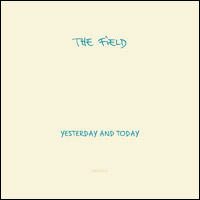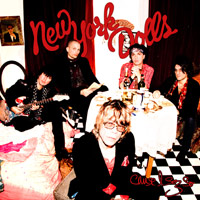
Yesterday and Today
Anti
For many, From Here We Go Sublime was the gateway drug into the dense world that could be found within minimalist house. Though the Cologne-based label Kompakt had been responsible for serving up this transcendent synergy of ambient and techno for more than a decade, it wasn’t until Alex Willner, a.k.a. the Field, approached his lab with the intentions of a pop songwriter that outsiders took notice. Forget whatever alchemy Willner used to incite universal praise for his work, after all it was illusion formed with infinitely clipped and looped samples (after eight minutes you’d be duped with Lionel Ritchie’s “Hello”), but Sublime gave the music a feel of being more human than machine.
In the time since that 2007 landmark release, bored with the typical presentation of the deejay, the Field became a band in the loosest sense. So for his next trick, Yesterday and Today, Willner has quite obviously created something using his past and present, an album that begins to incorporate the organic dynamics found in live drums and basslines without dissecting, or better, imploding his near-immortal techniques. It’s hard to imagine Yesterday and Today could expand upon the bedrock of Sublime and not have to remove itself from the original percept, but upon first listen the record sounds indistinguishable and completely recycled from its predecessor. Albeit cut with a scalpel from a different cloth, even a Kate Bush sample is re-used, and though in a different context, its tone is of pleasant familiarity.
Nothing on Sublime, though, could in reality be considered pop or the work of a songwriter, which makes as “Everybody’s Got to Learn Sometime” so striking. Adding vocals to an opiate Balearic beat, Willner transforms the track into an ode to the New Romantics, as if they started dabbling in neuro-rewiring and synesthesia. Blurring the line between the powder keg group vibe and digital precision, the title track fuses John Stanier’s (of Battles) prog-jazz drums on like an extra appendage. As on the album’s marathon closer, “Sequence,” Willner reveals the space between himself and the personage in the rest of the room, locking into a Kraut-stunner resurrecting visions of the autobahn. Even on the somewhat staid “Leave It,” where it appears as only a wash of sparkling chimes, Willner building loaded inertia in synth minutiae around the typical house pulse is what gives his craft such potency. Where Sublime merely triggered the senses, Yesterday and Today presents a drama and landscape in which to use them.
Kevin J. Elliott

’Cause I Sez So
Atco/Rhino
When the remaining members of the New York Dolls (singer David Johansan, rhythm guitarist Sylvain Sylvain and bassist Arthur Kane) resurrected that notorious band’s name in 2004, many assumed that it would be for just a few gigs and some shits and giggles. When Kane died of leukemia soon after, it seemed like that should have been the final nail in the coffin, so to speak. With three out of five principal members having tossed off their mortal coils (guitarist Johnny Thunders succumbed to a heroin overdose in 1991 and drummer Jerry Nolan died of a heart attack in 1992), what was the point to carrying on, especially some 30 years past their prime?
Of course, that’s exactly what Johansen and Sylvain have done, releasing One Day It Will Please Us to Remember Even This in 2006, with longtime Johansen collaborator Steve Conte standing in for Thunders, Sami Yaffa on bass and Brian Delaney on the skins. While the record didn’t exactly drag the band’s name through the mud, it couldn’t help but dirty their pristine two-album track record: 1973’s self-titled debut and the following year’s Too Much Too Soon. Perhaps in an attempt to bring back some of the spitfire of the old days, they brought in Todd Rundgren, who produced their eponymous LP, to man the controls for ’Cause I Sez So, album two from the Dolls, version 2. And again it wouldn’t be such a bad album if it didn’t say “New York Dolls” on the cover. As that’s the case, it’s hard not to hear the record as a mere pantomime of the band’s onetime nervy strut. The title track ain’t bad, and neither is “Muddy Bones,” but “This Is Ridiculous” lives up to its title via its blues aping. Perhaps even more ludicrous is the reggae-fied version of “Trash,” which conjures more Buster Poindexter than the Dolls of old. There’s certainly at least one or two former members rolling in their graves every time this version is played. You can’t begrudge Johansen and Sylvain their rightful legacy, but one can hope they’d know better.
Stephen Slaybaugh

Divided By Night
Ingrooves
Many years have passed since mainstream America’s electronica boom and the anointing of Ken Jordon and Scott Kirkland, better known as the Crystal Method, as America’s answer to the Chemical Brothers. While they’ve never matched the platinum success of their debut album, Vegas, the duo has maintained a steady profile, juggling albums, remix and soundtrack work. Now five years removed from their last album, the Crystal Method has returned with Divided By Night.
In the fast moving world of electronic music, you’re only as funky as your last hit. So in order to stoke the interest of fans that may have tuned out, Divided By Night is loaded with guest appearances. Out of the dozen songs on the record, nine feature guest artists, ranging from New Order’s Peter Hook to Granddaddy’s Jason Lytle. While the Crystal Method does adapt their style to suit each vocalist, the band stays very much in control. Still it’s good to see that they can rein in their aggressive style and deliver a song like the slow burning Meiko feature, “Falling Hard.” Overall, it’s not as disjointed as it could have been, but it still feels like a collection of singles rather than a complete work.
Since the guests are the focus of Divided By Night, it lives and dies on the strengths of those featured. Thankfully no one really lays an egg, but there are a few head scratching moments. The two songs featuring Peter Hook, “Dirty Thirty” and “Blunts and Robots,” are nothing special unless you were really dying to hear what the Crystal Method would sound like with snatches of New Order baselines. And current blog favs LMFAO’s lethargic contribution, “Sine Language,” is an almost painfully by the numbers “party jam.” But those missteps are balanced by the strong showings by Lytle and Metric’s Emily Haines.
The biggest problem with the Crystal Method is that even among a genre known for the relatively anonymous nature of its artists, there’s no sort of personality to the group. For example, if any of these songs came up in a random playlist you may not be able to tag them as Crystal Method songs. The craftsmanship is on point but disposable. The Crystal Method is a hard band to hate, but they’re equally harder to love. With Divided By Night, they’ve delivered a record that’s very easy to like.
Dorian S. Ham

Super Animal Brothers III
Carpark
Ear Pwr raise the argument that perhaps, through rapidly changing technology and bite-sized convenience, we really have spawned a generation whose only currency is attention-deficit culture. From Girl Talk (easy target) to Ear Pwr’s Wham City compadre Dan Deacon, we’ve settled into the notion that button pushers and knob twiddlers (or just iPods operators) can become musicians too. Or are they? Super Animal Brothers III is a perfect case study as Ear Pwr’s main influence is likely the Nintendo Entertainment System, at least if you take the album title at face value. It all depends on one’s tolerance for twee amphetamine electronix and high-school poetic nonsense.
If you go in with an open mind, despite the penetrating elf march histrionics (similar to Deacon’s chipmunk chants), you’ll notice on “You Are the Bomb” and “Boys II Volcanoes” that the duo of Devin Booze and Sarah Reynolds place skilled beats atop an atmosphere of rubber and static. “Future Eyes” is nothing more than evolved chiptune, the same way the world’s renowned video game composers crib from Wendy Carlos Williams and Hooked on Classics. “Diamond, Liquor, Leather” is where they stray. Ear Pwr revel in a juicy and fun strand of accelerated disco, but also reach a saturation point when it comes to how they party. Lines like “There are kittens in the pyramids. There are kittens on the ground,” make it difficult not to smirk (ironically). I guess we can blame it on white-rap and slam books, Power Rangers and Fisher Price—with this type of prolonged adolescence Ear Pwr do little to filter out the confectionary glitter.
Kevin J. Elliott
MP3: “Future Eyes”
ALBUM REVIEWS
Pink Mountaintops, Outside Love
Bob Dylan, Together Through Life
Tara Jane O'Neil, A Ways Away
Depeche Mode, Sounds of the Universe
Fischerspooner,
Entertainment
Mika Miko, We Be Xuxa
Magik Markers, Balf Quarry
Blake Miller, Burn Tape
Grand Duchy, Petits Fours
DJ Hell, Teufelswerk
Gliss, Devotion Implosion
Chairlift, Does You Inspire You?
Pterodactyl, Worldwild
Eat Skull, Wild and Inside
